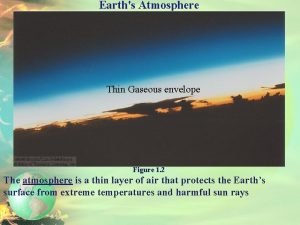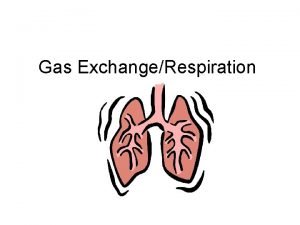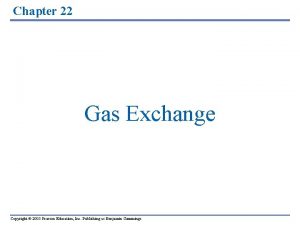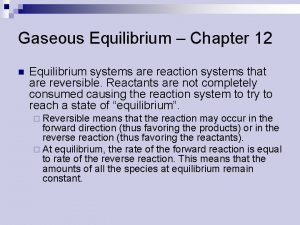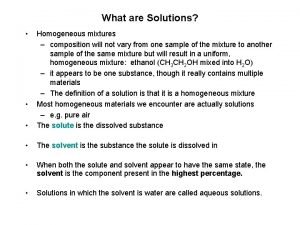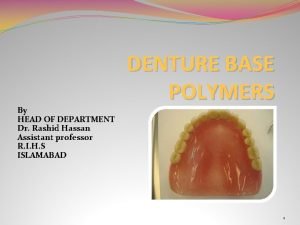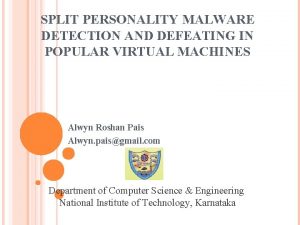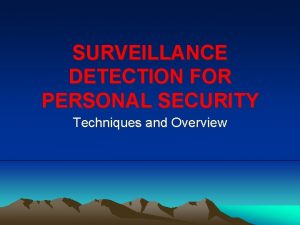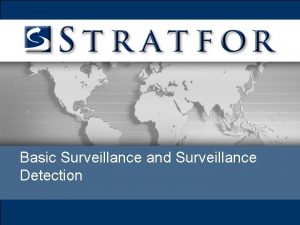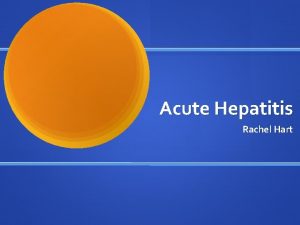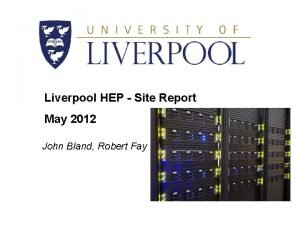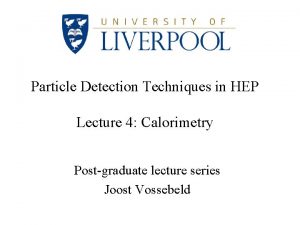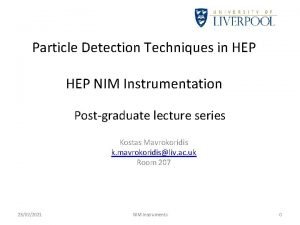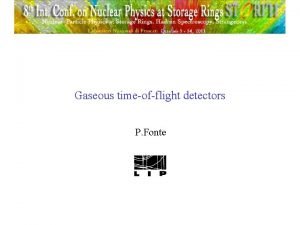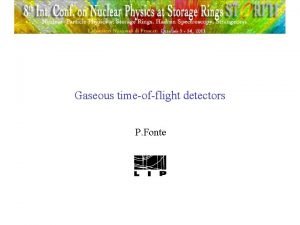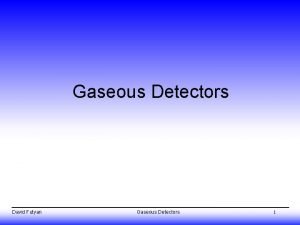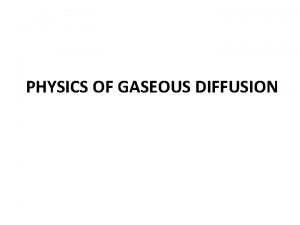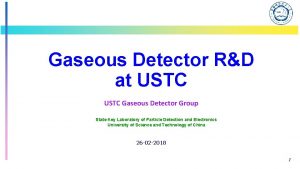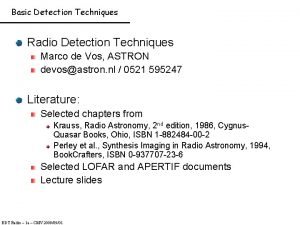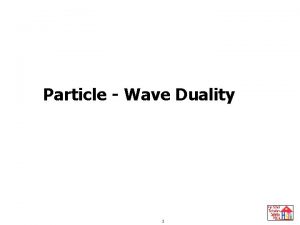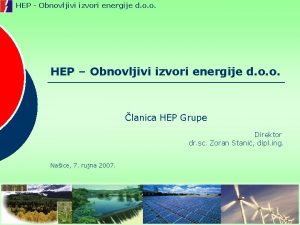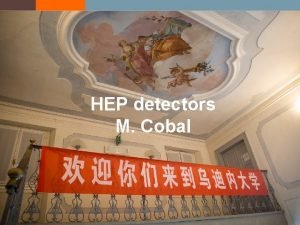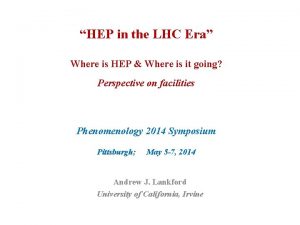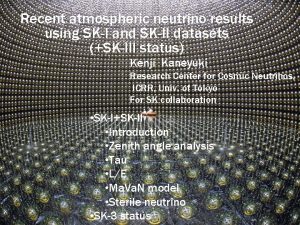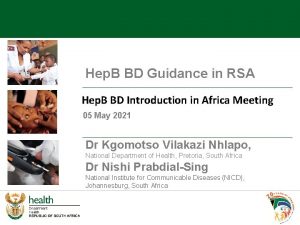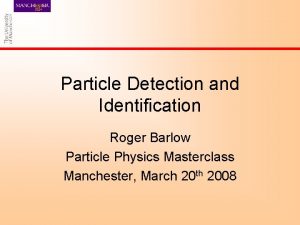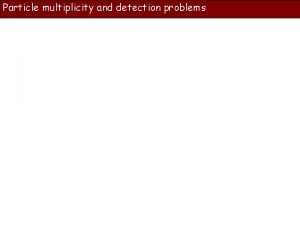Particle Detection Techniques in HEP Lecture 2 Gaseous




























- Slides: 28

Particle Detection Techniques in HEP Lecture 2: Gaseous Tracking Detectors Post-graduate lecture series Joost Vossebeld

Lecture 2 “Gaseous Tracking detectors” • • • Charged particles in matter (ionisation) Charge collection Operational modes of gas amplification Gas mixtures Electron and ion drift in a gas Multi Wire Proportional Chambers Drift Chambers Time Projection Chambers MSGC, GEMS and moving on to Silicon

Gaseous tracking detectors Gas is locally ionised by passing charged particles. With a strong electric field the produced free charge can be amplified to obtain a measurable signal. We can thus measure (for charged particles): • trajectories (direction and momentum) • d. E/dx (particle identification, lecture 5) In this lecture: • Ionisation • Gas amplification • Drift velocity • Various Gas Trackers

Charged particles in matter (1): Or (in relativistic notation): Kinetic energy transferred to target: The particle encounters both nuclei and electrons: Most energy is lost to electrons!

Charged particles in matter (2) How much energy does a particle lose travelling through matter of thickness Dx and density r? Area ring Mass encountered per unit areax Number of rings per unit area Number of electrons per kg

Charged particles in matter (3)

Full relativistic quantum mechanical treatment (Bethe & Bloch) PDG 2001

What about other mechanisms? I II III PDG 2001 I At very low energy ionisation impossible. Only interactions with nucleus. II For most particles ionisation dominates from a few Me. V up to Te. V-scale. III Above that Bremsstrahlung due to nuclear electric field dominates. Electrons (low mass) are an exception! Bremsstrahlung dominates from 5 -20 Me. V! (discussed later …)

Where does the lost energy go? Ionisation produces electron/ion pairs. Primary electrons have enough energy to cause secondary ionisation. F. Sauli, CERN 77 -09 In general we get ~100 pairs/cm

Diffusion and drift of electrons and ions in gas Diffusion: in the absence of an electric field charged particles move randomly loosing their energy quickly by multiple collisions with gas-molecules. Ions: Ion diffusion coefficient F. Sauli, CERN 77 -09 Electrons: diffusion is much faster as they have a longer mean free path.

Ion drift: In E-field ions move with net velocity w+ along the field lines The ion drift velocity w+ is proportional to the field strength. ALICE F. Sauli, CERN 77 -09 Ion mobility has weak (log) dependence on E! (i. e. the interaction cross section for ions is relatively independent of energy. ) Mobility is directly related to the diffusion coefficient: (i. e. diffusion is driven by temperature)

Electron drift: The drift velocity for electrons in an E-field, w, has a more complex dependence on E. Electrons (very light) accelerate quickly between interactions and have longer mean free path length. t: average time between collisions ( 1/ ) Strong dependence on gas-mixture, E and p. If your detector should measure drift times, choose voltage/gas where drift velocity is (almost) constant! F. Sauli, CERN 77 -09

Drift and diffussion in a magnetic field In our detectors we have magnetic fields as well. How does this affect the drift? Two common cases: Added component to the drift in direction of the Lorentz angle: Curved trajectory towards anode. Charge collection becomes a bit slower. Drift towards anode unaffected. Diffusion transverse to drift direction is forced in circles! Transverse diffusion remains small over large drift distance! Exploited in time-projection-chambers (TPC) (discussed later)

How to detect e/ion pairs produced by a charged particle? In E-field electrons(ions) drift to anode(cathode) But, 100 e/ion pairs do not constitute measurable signal (noise electronic amplifier typically ~1000 electrons or more). In a strong E- field (E > Ethreshold) electrons can obtain enough energy to cause further ionisation, thus producing an avalanche of e/ion pairs. (gas amplification) Simple particle detector: Gas filled tube with anode wire in the centre. (Using a very thin anode wire is an easy way to achieve a high field. ) T. S. Virdee: European School of High Energy Physics CERN 99 -04

Gas amplification T. S. Virdee: European School of High Energy Physics CERN 99 -04 a) Electrons(ions) drift towards anode(cathode) b) Gas avalanche produces more e/ion pairs c) Ion cloud reduces field and stops avalanche d, e) Electrons collected on anode, ions drift to cathode.

Operational modes of gas amplification Behaviour of gaseous detectors depends strongly on the field strength. I) very low field: partial (or no) charge collection. II) Ionisation mode: charge collection but no amplification III) Proportional mode: proportional charge amplification. Gain highly dependent on V! Streamer mode: proportionality lost by distortion E-field by space-charge. IV) Geiger or saturated mode: full ionisation of the gas volume (photo-emission). only stopped by interruption of HV In HEP: mostly chambers in proportional mode, sometimes streamer or saturated mode (can be read out without electronic amplifier!) T. S. Virdee: European School of High Energy Physics CERN 99 -04

The choice of gas(-mixture) The requirements: • High specific ionisation • Gas amplification at low working voltage and good proportionality • High voltage before saturation (high gain achievable) • High rate capability (fast charge drift & fast recovery) and long lifetime (of detector) Noble gases: • Few non-ionising energy loss modes avalanche multiplication at low V • Heavy gases (Ar, Xe, Kr) high specific ionisation • Excited Ar emits 11. 6 e. V photons free electrons at cathode new showers permanent discharge Poly-atomic gases: • Many non-ionising states effective absorption of ’s. (photon-quenching) e. g. Methane effectively absorbs ’s 7. 9 -14. 5 e. V. Organic gases: Methane, CO 2, BF 3, freons, isobutane (C 4 H 10) • Small admixture of photon-quencher prevents permanent discharge in e. g Ar! • Absorbed energy is released in break-up/inelastic collisions formation of radicals damage detector materials or leave solid or liquid organic deposits on anode or cathode • In a high rate environment gas may get fully quenched Gas must be circulated! Needed anyway to control gas mixture and because most detectors leak!

Multi Wire Proportional Chamber (MWPC) Charpak et al. (1968) Nobel prize 1992 Typically: L=5 mm & d=1 mm Electric field lines Electrons/ions drift along field lines. Ions cathode Electrons nearest anode wire! If all charge collected on 1 wire, resolution along x determined by wire spacing (pitch): (Gaussian width: ) d Charge sharing better resolution. PDG 2001 Original worry: Capacitive coupling between wires largely compensated by positive charge in avalanches. Only sensitive x-coordinate.

The y-coordinate hits • Crossed wire planes: ghost hits – Perpendicular (ghost hits when more than 1 particle!) – Stereo-angle (few degrees) only ghosts from hits near to each other • Two-sided readout – Charge division (resistive wire) – Time difference Note: velocity along wire 30 cm/ns so at best (x) ~ several cm • Segmented cathode planes – Strips/wires/pads (Slow!)

Drift chambers (examples of planar drift chambers) Field lines aligned with x-direction via use of field and sense wires. (cathode and anode wires) Then x can be measured from the arrival time. Better x-resolution while using larger wire pitch than in MWPC’s. Fewer wires g less electronics, less mechanical support As field is generated between wires various geometries possible: – Planar – Cylindrical – … Aim to get linear relation between position and arrival time! U. Becker, in: Instrumentation in High Energy Physics, World Scientific

Other drift chamber geometries Tubes or cells: • self supporting • less material at endsupport • “easier” to build C. Joram, CERN summer student lectures 2001 Cylindrical: • barrel shape • wires supported from end plates Straw tubes • very little material (centrally) • one broken wire can destroy large section! Honeycomb cells

Position resolution in drift chambers Remember electron drift velocity ~ few cm/ s: With timing precision of a few ns (x) ~100 m • Measurement precision: – Statistics primary ionisation (for small “cell”-sizes) – Electronics • Spread in arrival time: – Diffusion (especially for long drift paths) – Path length fluctuation complex in E-fields cell size

Time Projection Chamber (TPC) Large gas volume in high (longitudinal) E-field. Entire “track” drifts along z-axis. Readout chambers at both ends (e. g. MWPC’s) to measure projection of trajectory. Reconstruction of z from arrival times (slow drift, so good z resolution). Remember drift in B-field: E||B: transverse diffusion is suppressed (“helix”-shaped path) Slow readout. Potential problems with space charge. Ions drifting to central electrode. ALICE TPC: drift gas: 90% Ne, 10% CO 2

Pushing the limit to very small gaseous tracking detectors Future (high rate) experiments need small scale detectors to prevent having too many hit wires/strips per event. (occupancy=fractional hit rate per channel per event) Challenges for small & fast gaseous detectors: • small structures (detection elements) • high voltage to get enough charge • prevent (slow) ions from drifting back to cathode. There are several technologies for small scale gaseous tracking detectors: • Micro-strip gas chambers (MSGC) • Gas electron multipliers (GEM) • Micro-gap chambers • Micro-gap wire chambers • Micromegas • GEMs combined with pixel detectors • ……

Micro-Strip Gas Chambers (MSGC) PDG 2001 Example: CMS MCGC’s (abandoned) MSGC’s: • anode and cathode strips etched on glass substrate. • cathode strips provide fast “drain” for ions from avalanche High sensitivity to discharges, damaging strips.

Gas electron multipliers (GEMs) Thin perforated kapton foil, metal clad on both sides. (~500 V) Field lines squeezed through small gaps. This causes gas amplification in the gap. Less gas amplification needed near the anode strips. Invented to rescue MSGC technology. Interesting applications: with multiple GEM foils no longer need any charge multiplication near anode. Combine GEMs with strip or pad detectors or even Silicon pixel detectors to get thin (and thus fast) particle detectors.

Some difficulties with gaseous tracking detectors Difficult to build (and transport): • very thin wires need to be strung under tension (fragile) (one broken wire can destroy large section of chamber) • larger drift chambers need bulky end plates Complicated to operate: • gain highly sensitive to voltage/field strength -in some layouts small mechanical distortions can change behaviour detector (discharges). • behaviour is sensitive to (complex) gas mixture. • combination (often) organic gases with high voltage gives complicated ageing effects due to the effects of radicals/organic deposits. Nevertheless gaseous tracking detectors are widely used. Very successfully.

Next Lecture I II IV V Introduction Gaseous tracking detectors Semi-conductor trackers Calorimetry Particle identification
 01:640:244 lecture notes - lecture 15: plat, idah, farad
01:640:244 lecture notes - lecture 15: plat, idah, farad A thin gaseous layer that envelopes the earth
A thin gaseous layer that envelopes the earth Inorganic gaseous pollutants of air
Inorganic gaseous pollutants of air Gaseous exchange in animals
Gaseous exchange in animals Example of unit dosage form
Example of unit dosage form My very excited mother planets
My very excited mother planets Life science grade 11 gaseous exchange practical
Life science grade 11 gaseous exchange practical Skin gas exchange
Skin gas exchange Gaseous dosage form
Gaseous dosage form At 500 k one mole of gaseous oncl
At 500 k one mole of gaseous oncl Inorganic gaseous pollutants of air
Inorganic gaseous pollutants of air Exchange of gases in earthworm
Exchange of gases in earthworm Gaseous state chapter
Gaseous state chapter Gaseous equilibrium
Gaseous equilibrium Gaseous exchange in protozoa
Gaseous exchange in protozoa Gas and liquid solution example
Gas and liquid solution example Granular porosity denture
Granular porosity denture Non gaseous alkalosis
Non gaseous alkalosis Scoopyng
Scoopyng Surveillance detection techniques
Surveillance detection techniques Hostile surveillance detection point
Hostile surveillance detection point Hcv symptoms female
Hcv symptoms female Termoelektrana sisak
Termoelektrana sisak Hep b vaccine schedule for adults
Hep b vaccine schedule for adults Forum lhc
Forum lhc Hep b vaccines
Hep b vaccines Liverpool hep c
Liverpool hep c Chronic hepatitis
Chronic hepatitis Ana hep
Ana hep

